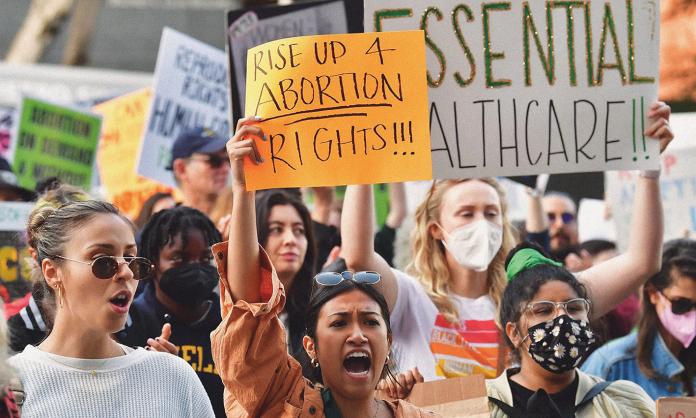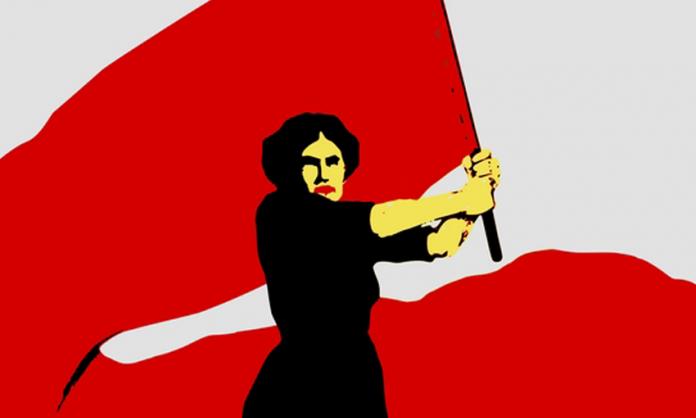Women’s rights in the US are at a critical juncture. A leaked draft Supreme Court judgement indicates that five conservative judges support overturning the 1973 Roe vs. Wade decision that established a woman’s right to abortion as a constitutional right.
In the event Roe is overturned, an estimated 25 states are expected to pass laws that restrict this right. Thirteen already have “trigger laws” in place in anticipation of the decision being overturned, many of which involve total abortion bans, including in cases of rape and incest.
This moment is the culmination of decades of campaigning by the US right wing. As recently as 2019, Republican leaders publicly argued that total abortion bans went too far and that they would provoke a backlash from a hostile public. Today, dozens of Republican-controlled state administrations are gleefully preparing to push such bans through, and the Supreme Court decision of nearly 50 years’ standing looks set to collapse. This has been the holy grail of the campaign to roll back the gains of the 1960s and ’70s.
That the right of women to control their own bodies rests so heavily in the US on a Supreme Court decision has always been a vulnerability. It makes the protection of the right to choose hostage to the composition of the nine-person court, which, as the various Trump appointees demonstrate, cannot be relied on to uphold basic rights.
To better secure abortion protection, pro-choice advocates have long argued for federal legislation to codify abortion rights, which would stand even in the event Roe was overturned. But so far, no administration has been willing to do this.
Barack Obama promised that passing a Freedom of Choice Act would be his first act as president. But once elected, he declared abortion rights no longer to be his “highest priority” and proceeded to do nothing about it throughout his two terms in office. Bill Clinton before him likewise failed to legislate despite promising to do so during his presidential campaign, instead popularising the slogan that abortion should be “safe, legal and rare” in what was widely seen as a concession to the anti-choice lobby.
So far in power, Biden has avoided even saying the word “abortion”, despite, like Democratic presidents before him, claiming to support codifying Roe and repealing the Hyde amendment (which bans federal funding for abortions).
Given that the Democrats currently control the House of Representatives, the Senate and the White House, the prospects should be good for passing federal protections. But they are not, in part because of hostility inside the supposedly “pro-choice” party.
In February, a Democrat-sponsored abortion rights bill was defeated in the Senate 48 votes to 46, after a prominent anti-choice Democrat from West Virginia, Senator Joe Manchin III, joined with the Republicans to vote against and other Democrats absented themselves from the vote.
Even if all the Democrats were prepared to vote for abortion rights, a 60 percent majority would be needed in the Senate in order to overcome the filibuster, a procedural rule that prevents a measure being voted on by opponents deliberately dragging out debate. But Manchin and other Democrats have indicated they oppose relaxing that rule, and Biden has shown no interest in pressuring them.
There is a range of other things the Biden administration could do to ensure women have access to proper reproductive services. But so far, the administration seems more interested in using the issue to boost the Democrats’ mid-term vote, even though the mid-terms, scheduled for November, will likely be some months after the Supreme Court’s decision is made official, expected in June or July. Posing as the pro-choice party without having to take meaningful action is an advantageous position for the Democrats, and is further evidence, if any were needed, of the problem with liberals and leftists orienting to the party as a force for change.
The Democrats’ history of capitulation and defensiveness towards the right has put the pro-choice movement in the US on the back foot. Few Democrats say without hesitation that women should be the ones who decide whether or not to proceed with a pregnancy, at whatever stage and for whatever reason, or that it is women and women alone who should make decisions about their bodies—not the state, their partners, religious figures or anyone else.
The right make no such apology for their position. They aggressively pursue it, despite being in a minority, successfully intimidating many of their opponents in the process.
Abortion is such an anathema to the right because it gives women the freedom to eschew their traditional role in the family, a social and economic institution that is indispensable to capitalism and venerated by the right. Even women being able to decide if and when they have children within a family structure is objectionable, because it alters the god-ordained balance of power in domestic life.
Eroding the right to choose is therefore not just about women being forced to have more babies. It’s also about pushing back against the idea that structures of authority should be subordinate to people’s needs and desires, rather than the other way around. The right wants to promote deference and respect for society’s ruling institutions: religion, the family, the economy, the nation, the police, borders. They resent any concession to the idea that people should be free to break from the expectations of tradition, as upheld by society’s ruling institutions. So women feeling they don’t have to defer—the very people who are meant to bind the social fabric together—is seen as an existential threat to capitalist order. Hence the obsession with denying women rights and promoting gender norms. And hence the right simultaneously advocate abortion bans and the death penalty despite the apparent contradiction: both are about individuals being subordinate to a higher power and the ruling institutions of society.
Despite the general backwardness of US society, there is nevertheless a clear democratic mandate to uphold abortion rights. A large majority of people agree abortion should be legal in most circumstances. But to achieve that, it is necessary to stand up to the powerful anti-choice forces both inside and outside the Democratic Party, as well as the anti-choice Republicans and increasingly triumphant right. What is needed is mass action, civil disobedience and a grassroots movement that turns the anger of millions of women and their supporters into a force that cannot be ignored. In a promising sign, thousands of abortion rights protesters have poured into the streets since the draft ruling was leaked, despite the passivity of the Democrat-aligned pro-choice bureaucracy. This is the hope for the future, and the only way ultimately to secure safe, free, legal abortion for all.
Socialists and the fight for abortion rights
For socialists, support for abortion rights has always been a no-brainer. Socialists support women having as much control as possible over their lives and bodies and fight for a society that ensures women are able to participate fully in social and political life regardless of how many or how few children they decide to have.
Socialists have also long recognised that reproductive rights are a class question. Wealthier women have always been able to pay for contraceptives and abortions and enjoyed the privacy and discretion that accompany wealth, while working-class women have been butchered by back-alley abortionists and poisoned by cheap abortifacients. To be truly a right, reproductive health care must be not only legal and safe, but also free.
In 1917, when the working class of Russia overthrew their rulers and took power, they quickly legalised abortion. Russian revolutionary Leon Trotsky called abortion “one of her [women’s] most important civil, political and cultural rights”, and he later condemned the Stalinist counter-revolution that revoked it. Communist parties around the world were also early supporters of women’s reproductive rights, emphasising that it needed to be free and accessible if it was to mean anything for working-class women.
In the 1970s, an explosion of working-class struggle and the rise of the women's liberation movement gave the fight for abortion rights its most radical push yet. In Australia, the Women’s Abortion Action Campaign organised mass action in the streets to “fight the reactionary media, church men and politicians who daily intimidate women into believing they have no right to control their own bodies”. They started with small rallies, but through determined activism and with the help of left-wing trade unions, they pushed the Whitlam government to provide Medicare funding for abortions.
In recent years, even in heavily Catholic countries where the church is highly influential, mass movements have smashed the barriers to accessing abortion. Governments in Colombia, Argentina and Ireland have been forced to legalise abortion. That sort of fight is what’s needed in the US now.










